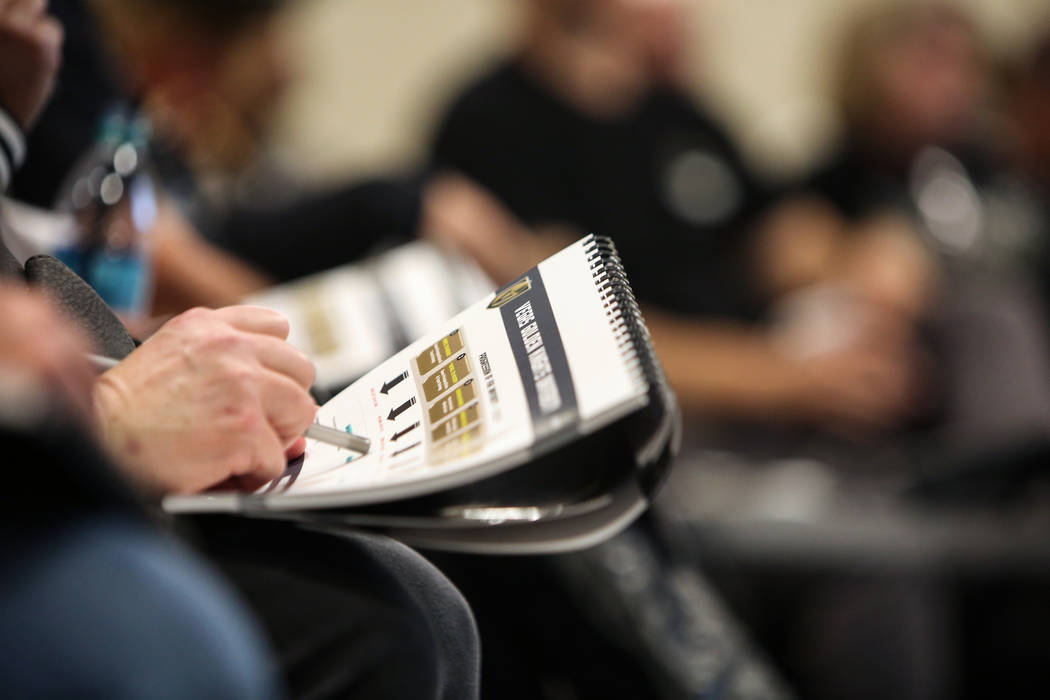Vegas Golden Knights’ classes let fans skate on T-Mobile ice











Among the things you learn as part of VGK University, the Golden Knights’ educational program for new hockey fans:
■ The ice at T-Mobile Arena is 1½ inches thick.
■ That ice is consistently rated by players and referees as among the best in the NHL.
■ If you’re making your first attempt at a slap shot despite being uncomfortable on hockey skates, there’s a decent chance your backside will become intimately acquainted with that ice.
You may even sit down so hard, you’d swear you can feel everything — the concrete, the layer of sand and the dozen or so miles of pipes — beneath its surface.
Falling certainly isn’t in the lesson plan. It’s just something you pick up — speaking from personal experience — during the hour of on-ice instruction offered as part of the monthly sessions.
“It’s important for us to give back to the community and to continue to educate our fans about the game of hockey and about the Vegas Golden Knights,” Misha Donskov, the team’s director of hockey operations, said Oct. 24 after the season’s first Hockey 101 class.
“I thought the ice session today was great. You see them out on the ice with their cellphones, taking pictures, taking video.”
At least that was the case with the handful of enrollees who weren’t struggling to stay upright.
‘Terrified and excited’
It began as a wobbly march through the bowels of T-Mobile Arena, past the Zambonis and the game goals that are brought out between warm-ups and the puck drop, as ankles strained to adapt to the blades beneath them.
VGK University students must be at least 21 years old, but no one in the first class, made up of more women than men, was in any danger of being carded. Some played hockey as children. Others brought their own skates. At least one recently joined a learn-to-play program. More than a few, though, hadn’t skated in decades — if at all.
The closer the group got to the ice, you could almost hear the mental calculus of weighing the desire to make the most of the lifelong — or, in many cases, several monthslong — dream of skating in an NHL arena against the chance of breaking a hip. Or two.
“I’m equally terrified and excited,” one attendee admitted as she approached the ice as though she were gingerly stepping down the Green Mile. Those fears gave way to unbridled joy, though, when she learned walker-style skating aids were available. Clutching the assister tightly, she soon was being maneuvered around the playing surface by Murray Craven, an 18-year NHL veteran and the team’s senior vice president of hockey operations.
Logging ice time
Intimidation aside, the Knights’ home ice actually is one of the easier surfaces on which you could ever hope to skate. Unlike public rinks, there are no ruts in the ice for your blades to get stuck in, and there’s a complete lack of falling children to dodge. Still, things can get a little harried when the sticks and pucks come out.
The ice time is optional — several class members watched from the seats — but it’s a bucket-list item that shouldn’t be missed if you’re at all capable. Swaddle yourself in bubble wrap if need be.
Sliding around in goal, you can see firsthand how much smaller Marc-Andre Fleury’s crease is in real life. (Relax, it’s a hockey term for the blue area in front of the goal.)
Puck handling isn’t necessarily taught, but Craven spent several minutes feeding the rubber discs to a small group so they could feel the thrill of putting the biscuit in the basket.
Want to attempt a between-the-legs game winner like William Karlsson or crash the boards a la Ryan Reaves? The only things stopping you are common sense and your insurance deductible.
The experience is exhausting.
You’ll sweat through everything you’re wearing despite the cold.
And you’ll leave with a whole new appreciation for why the average shift in an NHL game lasts only 45 seconds.
Covering the basics
An hour into the classroom session that followed, the fire alarm began echoing throughout the arena. Barely audible over the racket, a woman announced, “I’m not movin’!”
Such was the appeal of learning the basics of the sport from Donskov and Craven, who broke down footage from various Golden Knights games. The two patiently answered questions on topics as wide-ranging as strategic player placement during face-offs — showoff — to whether, after all their years in hockey, their teeth are real to “Why does it seem like the refs always allow penalties against the Knights?”
It didn’t take long for the students to grasp the basics. Donskov’s question, “What do we want in the neutral zone?” was met with a resounding “Speed!”
News that the lesson was about to explain icing was accompanied by a cry of “Good!” (In the most basic terms, icing leads to a face-off whenever a player shoots the puck and it travels untouched past the red center line and the opponent’s goal line.)
When the lesson turned to offsides, Donskov produced the official explanation — “This is from the NHL rule book. You can read it tonight. It’ll help you sleep” — before clarifying the infraction. “Offsides, in the most simple way: The puck has to cross the offensive blue line first before any member of the attacking team.”
Learning more
The Oct. 24 class, which will be repeated Nov. 16 for full-season ticket holders, was titled “Intro to Hockey.” As basic as the instruction is, it really does affect how you watch the sport, which is one of the reasons the classes always take place before home games.
Line changes that may have seemed arbitrary or reactionary make more sense when you realize the strategy behind the dump-in — the long pass into space in the offensive zone — that often precedes them.
Kathleen Wiltshire of Henderson was most interested in going behind the scenes of the arena and hitting the ice. “Physically, I feel fine,” she said of the skating. “I was getting a little tired there at the end.”
She’s already planning to return for one of the future sessions — Dec. 9 will cover creating offense, Jan. 23 will be dedicated to defensive strategy, Feb. 9 will focus on special teams and Feb. 22 is billed as “A Day in the Life of a Coach” — alongside her friend Michelle Mazzanti, also of Henderson.
“I just wanted to learn more about the game,” Mazzanti said, “because most of the time I’m up there cheering and I don’t know why — and sometimes at the wrong time — so this has taught me a lot.”
Contact Christopher Lawrence at clawrence@reviewjournal.com or 702-380-4567. Follow @life_onthecouch on Twitter.












